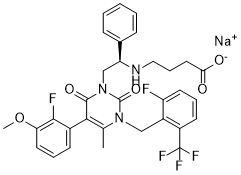All AbMole products are for research use only, cannot be used for human consumption.

Elagolix displays high affinity in a competition binding assay for hGnRH-R (Ki = 0.90 nM) and low CYP3A4 inhibition (IC50 = 56 μM). Elagolix is highly selective at hGnRH-R, its wider receptor selectivity is tested at a concentration of 10 μM in a panel of radioligand binding assays for 100 off-target receptors, ion channels, enzymes, and transporters, and significant activity is not observed (inhibition <50%).
In vivo, oral administration of Elagolix suppresses luteinizing hormone in castrated macaques. Elagolix shows good efficacy in suppressing luteinizing hormone in monkeys and exhibits high oral bioavailability in dogs (~100% when dosed via oral gavage at 50 mg/kg).
| Cell Experiment | |
|---|---|
| Cell lines | RBL-1 cells stably expressing the human cloned GnRH receptor |
| Preparation method | RBL-1 cells stably expressing the human cloned GnRH receptor are seeded into 96 well plates at a density of 15 000 cells per well in inositol-free DMEM containing 10% dialyzed FBS, 10 mM HEPES, 2 mM L-glutamine, 1 mM sodium pyruvate, 0.1 mM nonessential amino acids, and 50 μg/mL penicillin/streptomycin and are labeled for 48 h with 0.2 μCi myo-2-[3H]inositol. The cells are washed once in PBS and pretreated with assay buffer (140 mM NaCl, 4 mM KCl, 20 mM HEPES, 8.3 mM glucose, 1 mM MgCl2, 1 mM CaCl2, 10 mM LiCl, and 0.1% BSA) for 15-60 min at 37 °C. The cells are then stimulated with GnRH (6 nM) in the presence or absence of antagonist and incubated for 60 min at 37°C. Cells are extracted with 10 mM formic acid at 4°C for 30 min, and the lysate is loaded onto Millipore plates containing 20 μg of Dowex AG1-X8 resin. The plate is washed once in H2O and once in 60 mM ammonium formate/5 mM sodium tetraborate, and inositol phosphates are eluted with 1 M ammonium formate/0.1 M formic acid. The eluate is transferred to a Lumaplate and counted in a TopCount NXT. |
| Concentrations | - |
| Incubation time | 1 h |
| Animal Experiment | |
|---|---|
| Animal models | Rhesus Monkey |
| Formulation | water or 5% cromophore (For i.v. formulation); a sterile water solution (For oral formulation) |
| Dosages | 10 and 50 mg/kg (oral); 3 and 10 mg/kg (i.v.) |
| Administration | p.o. or i.v. |
| Molecular Weight | 653.57 |
| Formula | C32H29F5N3O5.Na |
| CAS Number | 832720-36-2 |
| Solubility (25°C) | DMSO: ≥ 85 mg/mL |
| Storage |
Powder -20°C 3 years ; 4°C 2 years In solvent -80°C 6 months ; -20°C 1 month |
| Related Estrogen Receptor Products |
|---|
| GDC-0927
GDC-0927 (SRN-927) is a novel, potent, non-steroidal, orally bioavailable, selective estrogen receptor antagonist. |
| AC-186
AC-186 is a selective non-steroidal estrogen receptor β (ERβ) agonist with EC50s of 6 nM and 5000 nM for ERβ and ERα, respectively. |
| Idoxifene
Idoxifene (CB7432) is a novel tissue-specific selective estrogen receptor modulator (SERM). |
| (R)-Equol
(R)-Equol is an agonist of both ERα and ERβ with Kis of 27.4 and 15.4 nM, respectively. |
| (Rac)-Vepdegestrant
(Rac)-Vepdegestrant is the isomer of Vepdegestrant. |
All AbMole products are for research use only, cannot be used for human consumption or veterinary use. We do not provide products or services to individuals. Please comply with the intended use and do not use AbMole products for any other purpose.


Products are for research use only. Not for human use. We do not sell to patients.
© Copyright 2010-2024 AbMole BioScience. All Rights Reserved.
